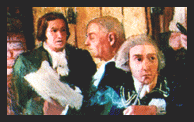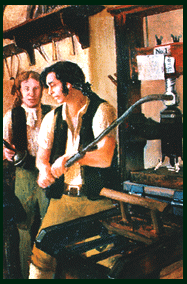|
Art and paintings of the
|
||
|
ISAIAH THOMAS |
||
|
|
 |
|
|
Union St.,
Boston, 1771-1775 Throughout this time he made many contributions to writings on human rights and individual freedom. His scathing criticisms of the ruling British authority had many times endangered his own life. The numerous gatherings of founding patriots and these writings earned his printing shop the deserved reputation as "The Sedition Foundry" (see below). It was partially through his newspaper, 'The Massachusetts Spy', and a host of his other publications that many of the colonists in New England learned the facts of the oppressive conditions imposed upon them by the ruling British authorities. His newspaper and his patriotic efforts had in many ways fueled the flames of the American Revolutionary War. The events of Isaiah Thomas's activities in Boston relating to the developments of the American Revolutionary War were imagined in paintings commissioned by the historic landmark, The Union Oyster House, in Boston. The images of these paintings were made into prints with text describing these events. |
||
|
Isaiah Thomas (above
center) was born youngest of three into a poor Boston family on January
19, 1749. From the ages of six through sixteen, Isaiah was indentured as
an apprentice to a Boston printer, Zachariah Fowle, where he learned his
trade. In 1767, Thomas lived in Halifax. He worked on the Halifax Gazette against the Stamp Act, a British Parliamentary tax law of 1765 and took such a strong stand against this measure that he was fired. In 1767 at 18, Thomas settled for two years in Charleston, South Carolina, and worked as a journeyman printer. On Christmas day of 1769, he married Mary Dill, and moved to Boston in the spring of 1770 where he began a partnership with his former master, Fowle. The first samples of The Massachusetts Spy were issued on July 17, 1770. By October 23, 1770 , Fowle sold his interest to Thomas. At the end of October 1771, Isaiah Thomas moved his print shop to a house on the "south corner of Marshall Lane, leading from Mill bridge into Union Street". |
||







